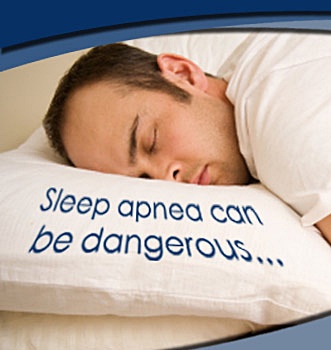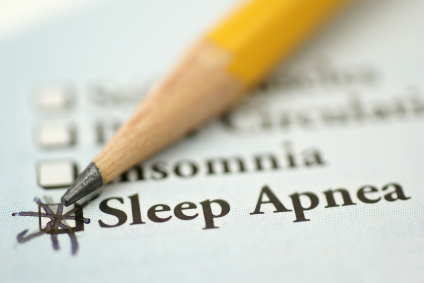Let’s bullet these points since there is so much text so when you click on the question it can jump to that section without having to scroll all the way down. Thanks!
 Simply Snoring or Something More?
Simply Snoring or Something More?
If you snore, you may know about nightly jabs in the ribs and grumbling from your bed partner. The noise you make can disrupt their sleep- and your own. It may even be a sign of a more serious problem called Sleep Apnea.
Sleep Apnea is a serious disorder in which the sufferer's airway relaxes and closes during sleep, preventing the body from getting critical oxygen. Sleep apnea is a disorder characterized by a complete or partial cessation of breathing during sleep. The interruptions in breathing, called apneas, can cause a host of other dangerous medical conditions. Heavy Snoring if often a warning sign of Sleep Apnea. Due to the lack of oxygen and numerous arousals throughout the night the sufferer's overall health can be seriously harmed by Sleep Apnea.
There are three types of sleep apnea: central, obstructive, and mixed. In central sleep apnea (CSA), the brain fails to instruct the body to breath. Obstructive sleep apnea (OSA) is far more common than central sleep apnea. In obstructive sleep apnea the upper airway repeatedly collapses during sleep, either completely or partially preventing air from reaching the lungs. Mixed sleep apnea is a combination of central and obstructive.
The gaps in breathing occur between 5 and 100 times per hour depending on the severity of the condition and typically last between 20 and 40 seconds. In some cases, breathing can even stop for several minutes at a time. During each lapse in breathing, oxygen levels in the blood drop. When the brain registers this change, it arouses the body to wake up which reopens the airway but also interrupts sleep. A gasp or choking sound can often be heard as breathing resumes. The person will typically fall back asleep with no memory of being woken up which makes sleep apnea hard to recognize. The condition is typically identified by spouses or family members who notice heavy snoring and gaps in breathing. As a result of repeatedly being woken up throughout the night, the person fails to sustain deep sleep and may feel tired throughout the day.
Untreated sleep apnea can:
- Increase the risk for high blood pressure, heart attack, stroke, obesity, and diabetes
- Increase the risk for or worsen heart failure
- Make irregular heartbeats more likely
- Increase the chance of having work-related or driving accidents.
 What Causes OSA?
What Causes OSA?
When you're awake, throat muscles help keep your airway stiff and open so air can flow into your lungs. When you sleep, these muscles are more relaxed. Normally, the relaxed throat muscles don't stop your airway from staying open to allow air into your lungs. Not enough air flows into your lungs when your airways are fully or partly blocked during sleep. This can cause loud snoring and a drop in your blood oxygen levels.
When the oxygen drops to dangerous levels, it triggers your brain to disturb your sleep. This helps tighten the upper airway muscles and open your windpipe. Normal breaths then start again, often with a loud snort or choking sound. The frequent drops in oxygen levels and reduced sleep quality trigger the release of stress hormones. These compounds raise your heart rate and increase your risk for high blood pressure, heart attack, stroke, and irregular heartbeats. The hormones also raise the risk for or worsen heart failure.
Untreated sleep apnea also can lead to changes in how your body uses energy. These changes increase your risk for obesity and diabetes
Certain anatomical characteristics make the airway more susceptible to collapse. A large tongue, enlarged tonsils (especially in children) and an extended palette, and an enlarged uvula all increase the chances of obstruction. Individuals with overbites or small, receding jawlines are more likely to have their airway blocked. Alcohol, sedatives, and some medications can also increase the likelihood of obstruction by inducing relaxation of the throat muscles. As individuals age and their muscles become less taught, their risk of obstruction is elevated.
There are also certain factors that narrow the circumference of the airway itself, making obstruction more likely. Excess deposits of fat around the neck area—those with necklines that are 16 inches or more—can reduce the girth of the airway. Men, who on average have a higher BMI (body-mass index) than women, are more likely to have sleep apnea. Another factor that narrows the airway is smoking. Smoking can irritate the back of the throat and narrow the airway.
There is also a strong genetic component to sleep apnea. Those with family members who have sleep apnea are at higher risk of having sleep apnea themselves.
Symptoms
Major symptoms of sleep apnea include:
• Loud, persistent snoring. The loud snoring is often followed by periods of silence when the airway is completely obstructed. These pauses are often followed by gasps or choking sounds as the person resumes breathing.
• Unexplained daytime sleepiness. People with sleep apnea are prone to dozing off while at work or driving or even during conversations. Sleep apnea sufferers are up to six times as likely to get into repeated auto accidents.
• Poor sleep. Since the brain repeatedly jolts the body to wake up and resume breathing, sleep quality is disturbed throughout the night.
Other symptoms include:
- Hypertension
- Morning headaches
- Difficulty concentrating
- Forgetfulness
- Mood disturbance
- Anxiety
- Depression
- Frequent urination at night (nocturia)
- Sore throat or dry mouth in the morning
- Insomnia
- Night sweats
- Unexplained weight gain
- Increased heart rate
- Diminished sex drive
Children with sleep apnea may exhibit hyperactivity, poor academic performance and hostile behavior. Bedwetting and unusual sleep positions are also seen in children with sleep apnea.
Am I At Risk for Sleep Apnea?
- It's estimated that more than 12 million American adults have obstructive sleep apnea. More than half of the people who have this condition are overweight.
- Sleep apnea is more common in men. One out of 25 middle-aged men and 1 out of 50 middle-aged women have sleep apnea.
- Sleep apnea becomes more common as you get older. At least 1 out of 10 people over the age of 65 has sleep apnea. Women are much more likely to develop sleep apnea after menopause.
- African Americans, Hispanics, and Pacific Islanders are more likely to develop sleep apnea than Caucasians.
- If someone in your family has sleep apnea, you're more likely to develop it.
- People who have small airways in their noses, throats, or mouths also are more likely to have sleep apnea. Smaller airways may be due to the shape of these structures or allergies or other medical conditions that cause congestion in these areas.
- Small children often have enlarged tonsil tissues in the throat. This can make them prone to developing sleep apnea.
What Are The Health Risk Factors For Sleep Apnea?
- Memory Loss
- Lack of Energy
- Drowsy Driving
- Cardiovascular Strain
- Erectile Dysfunction
- Increased Risk for Accidents
- Weight Gain
- Depression
- High Blood Pressure
- Stroke
- Excessive Stress.